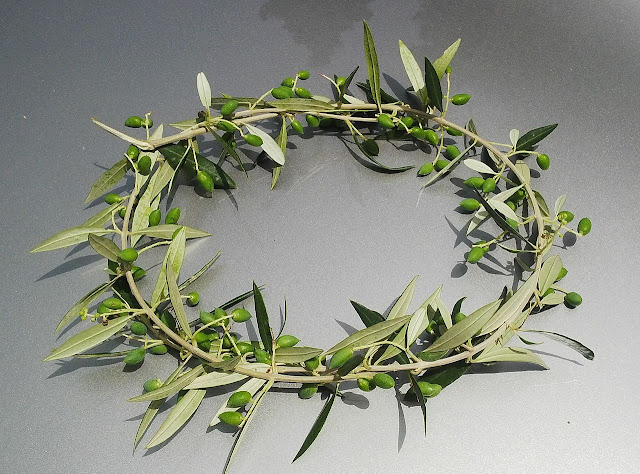The Olympic Games were born in Ancient Greece, at the sacred site of Olympia, in 776 BCE. The Games, created by Heracles in honour of the Father of the Gods, Zeus, were held every four years and attracted great athletes and a lot of spectators. One of the most interesting aspects of the Games was that all these athletes competed and gave their all for one single prize. A kotinos, a wreath made from the branches of a wild olive tree which was near the Temple of Zeus in Olympia. No gold, no silver , no bronze medals. Just a wreath for the best athlete in each sport. And yet, this seemingly 'humble ' wreath was cherished more than any other material prize.
As we mentioned before, the kotinos was made from the branches of a wild olive tree called Elaia Kallistephanos) . Hercules, who first laid out the Olympic track, also planted this sacred olive tree from which the wreaths were made. It is therefore clear that the wreath was not just a prize for athletic success; it was a sacred offering, imbued with cultural and religious significance. Hence , the process of making an olive wreath was a task of precision and reverence. Before the beginning of the Games, the branches of the sacred wild-olive tree were cut by a pais amphithales (Ancient Greek: παῖς ἀμφιθαλής, a boy whose parents were both alive) with a golden sickle. Then he took them to the temple of Hera and placed them on a gold-ivory table. From there, the Hellanodikai (the judges of the Olympic Games) would take them, and carefully weave them into wreathes, ensuring that each one was a perfect circle, symbolizing unity and eternity.
The use of olive tree branches as awards for the most important athletic event of the ancient worlds, reminds us once more of the special place the olive tree held in Hellenic Religion and culture. It is the sacred tree of Goddess Athena, who had gifted it to the city of Athens, winning the favor of its people over Poseidon. The connection of the olive tree to the Greek Goddess of Wisdom enhances its significance as a symbol of wisdom, peace, and prosperity.
The climax of the Olympic Games was the award ceremony, where victors were crowned with olive wreaths. This momentous occasion took place within the sanctuary of Zeus, adding a divine dimension to the athletes’ triumph. The ceremony was not just an athletic celebration but a religious and cultural festival, attended by thousands, including dignitaries and priests.
More Than Just a Prize
In the ancient Greek Olympic Games, there was only one winner per sport. Therefore, winning an olive wreath in Olympia was one of the truly highest honors for an ancient athlete. The fact that the kotinos wasn't an 'expensive' prize was unimportant. Its true value was that the victor had earned the glory of victory, the respect of his peers and his home town and most of all, the favour of the Gods. The Kotinos was also a testament to the athlete’s physical prowess, dedication and discipline.
Famous Victors Who Received Olive Wreaths
The victorious athletes were honoured, feted, and praised. Their deeds were heralded and chronicled so that future generations could appreciate their accomplishments. In fact, the names of the Olympic winners formed the chronology basis of the ancient world, as arranged by Timaeus in his work, The Histories. Over the centuries, numerous athletes achieved glory in the Olympic Games and were honored with olive wreaths. Their victories became part of the rich tapestry of Greek history .Athletes like Diagoras of Rhodes, who won twelve crowns in the Olympics, and Milo of Croton, a renowned wrestler, were among those who received this prestigious honor. Their victories, celebrated with olive wreaths, elevated them to a near-mythical status, immortalizing their names in the annals of history.
The kotinos was not only a symbol of athletic victory ,but also of peace. The olive branch has traditionally been associated with peace and reconciliation, and its use in the wreaths at Olympia further emphasized the Olympic Truce, during which conflicts were suspended, and unity was celebrated.
Olive Wreaths in Modern Olympic Symbolism
Just like the Olympic Games themselves, which gloriously returned in the modern era, the tradition of the olive kotinos has transcended the centuries, finding its place in the modern Olympic Games. While gold, silver, and bronze medals are awarded to modern day athletes, the olive wreath still appears in various symbolic forms. It is often seen in logos, emblems, and the ceremonial aspects of the Games, serving as a link to the ancient traditions and a reminder of the Olympic Games’ Greek historical roots. Olive wreaths were the official emblem of the 2004 Summer Olympics in Athens, where the athletes also received them in honor of the ancient tradition.
For the conclusion of this short article about the history of the kotinos, it is worth mentioning an account given to us by Herodotus : Xerxes was interrogating some Arcadians after the Battle of Thermopylae. He inquired why there were so few Greek men defending the Thermopylae. The answer was "All other men are participating in the Olympic Games". And when asked "What is the prize for the winner?", "An olive-wreath" came the answer. Then Tiritantaechmes, one of his generals uttered: "Good heavens! Mardonius, what kind of men are these against whom you have brought us to fight? Men who do not compete for possessions, but for virtue."'
Edited from : Wikipedia , peloponnesetravel.gr














